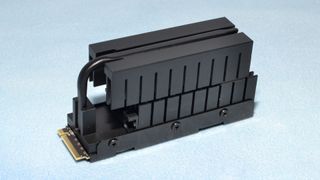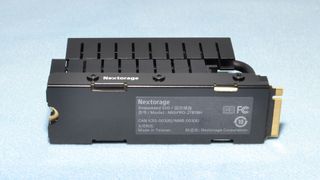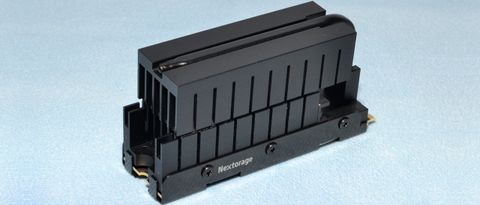Tom's Hardware Verdict
Another day, another fast Gen 5 SSD. The Nextorage NN5Pro pushes the envelope for what’s currently possible with a consumer SSD, but its only standout feature is an optional, massive heatsink.
Pros
- +
Top performance tier, for now
- +
Solid all-around and sustained performance
- +
Optional, massive heatsink to keep it cool
Cons
- -
Poor availability
Why you can trust Tom's Hardware
The monstrous Nextorage NE5N Gen 5 SSD now has an equally monstrous but faster sibling. Presenting the Nextorage NN5Pro: a ridiculously fast SSD that can reach up to 12 GB/s without breaking a sweat, thanks to its overdesigned heatsink. It very well may be one of the fastest drives on the market, if you can find it, but this isn't a drive you’ll be squeezing into your laptop or PS5 - even if you get the bare version of it - as it’s power-hungry and hot-running. It fits the bill if you want to show off your high-end desktop build, though.
Nextorage is not a new name to us, as we reviewed the 10 GB/s NE5N earlier this year, although we did not formally review the Gen 4 NEM-PA. Nextorage began its life as a Sony venture, based in Japan and selling that drive for the PS5 console. That partnership with Phison ended when the latter decided to take over the brand for itself. In recent news, Phison communicated its intention to prepay for NAND to ensure a sufficient supply, which has ramifications for Nextorage and other drives.
That includes the Crucial T500, which we recently reviewed. The T500 uses the unique E25 SSD controller from Phison in what seems to be a partnership, and possibly exclusive at that. Crucial previously utilized in-house controllers built by the team and IP from its Tidal Systems purchase, a team with ties to SandForce and LAMD. These controllers appeared in the P5 and P5 Plus, but the more recent P3 and P3 Plus use the Phison E21T controller, which includes the former in an exclusive PCIe 3.0 mode. Phison relies on Micron’s flash for its E26 drives thus far, so it’ll be interesting to see if market conditions and Phison’s management of Nextorage will bear fruit in the future.
Right now, it isn’t easy to get information on the NN5Pro besides listings in Japan. If the NE5N’s history is any indication, the NN5Pro will make its way into other regions and will probably be sold at a discount. The Crucial T700 has a more reasonable cooling solution, and the Teamgroup Cardea Z540 comes essentially bare, leaving the NN5Pro in an interesting spot. If you need a very fast drive with excellent cooling, though, it has few rivals.
Specifications
| Product | 1TB | 2TB |
|---|---|---|
| Pricing | N/A | N/A |
| Form Factor | M.2 2280 | M.2 2280 |
| Interface / Protocol | PCIe 5.0 x4 / NVMe 2.0 | PCIe 5.0 x4 / NVMe 2.0 |
| Controller | Phison E26 | Phison E26 |
| DRAM | 2GB LPDDR4 | 4GB LPDDR4 |
| Flash Memory | 232-Layer Micron TLC | 232-Layer Micron TLC |
| Sequential Read | 11,700 MB/s | 12,400 MB/s |
| Sequential Write | 9,500 MB/s | 11,800 MB/s |
| Random Read | 1.3M IOPS | 1.4M IOPS |
| Random Write | 1.4M IOPS | 1.4M IOPS |
| Security | TCG Opal | TCG Opal |
| Endurance (TBW) | 700TB | 1,400TB |
| Part Number (w/o HS, w/HS) | NN5PRO-1TB1BN NN5PRO-1TB1BH | NN5PRO-2TB1BN NN5PRO-2TB1BN |
| Warranty | 5-Year | 5-Year |
The Nextorage NN5Pro comes in 1TB and 2TB capacities, omitting the 4TB option of the NE5N. Speeds are faster, though, at up to 12,400 / 11,800 MB/s for sequential reads and writes and up to 1.4M / 1.4M random read and write IOPS. SSDs with the Phison E26 controller, based on an enterprise design, typically have TCG Opal support for encryption. The NN5Pro is otherwise unremarkable, with a 5-year warranty at up to 700TB of writes per TB capacity.
Getting full information on this drive is difficult as it’s still hard to find, but it looks like Nextorage intends to sell both heatsinked and non-heatsinked variants.
Software and Accessories
Software support is minimal, but Nextorage does offer a download of Acronis True Image OEM on its website. This application can assist with cloning, imaging, and backup.
A Closer Look

Our NN5PRO arrived with a huge heatsink identical to the previously reviewed NE5N. This heatsink is clearly overkill and precludes the drive’s use in a laptop, PS5, or even some desktops. On the bright side, it’s more than sufficient to keep this Gen 5 drive cool under almost any conditions. We’re not huge fans of the looks, but it does work well. Luckily, Nextorage also offers a variant of this drive without a heatsink, although you will have to provide your own heatsink in that case.
The drive is double-sided, and the heatsink has several parts to it. This includes multiple thermal pads for both sides of the flash, the DRAM package, and the underside of the SSD controller. The top side of the controller has thermal grease, and it touches the topmost heatsink via a copper interface. This wicks heat away with a heatpipe to the top heatsink, separated from the lower flash heatsink with cushioning material. The backside of the entire cooling structure is a simple metal plate. Thus, the entire drive and all of its components are cooled, but the controller gets the most attention.

The “H” at the end of the model number refers to the heatsink, while the “N” variant lacks a heatsink. No 4TB version of this drive is currently listed, unlike the NE5N, which might be related to the difficulty of procuring faster flash. There’s been some difficulty with the availability of 4TB Gen 5 drives, and even the Gen 4 Crucial T500 - which uses this flash to good effect - has put off that SKU until next year. This is troubling as 232-Layer TLC from YMTC is commonplace and inexpensive on 4TB drives, including the Lexar NM790 and Addlink A93.
It’s difficult to get clear answers from Phison or Crucial/Micron on why this is the case specifically. Certainly, it’s challenging to maintain 2400 MT/s, but the memory marketplace also likely plays a role. When you think about it, ridiculously fast Gen 5 SSDs are still pretty niche. This is to say that trickling out drives, especially since Crucial controls the flash supply with a Phison controller partnership, is a reasonable strategy.
This opens the door to some good things with the Maxio MAP1602 SSD controller and YMTC flash if you need 4TB for most applications, with Crucial’s T500 being a pretty strong answer to anything else. Otherwise, you are somewhat reliant on QLC to fill the gap at 4TB, which is accomplished with the Crucial P3, the Crucial P3 Plus, and the Corsair MP600 Core XT. Stepping up to the 4TB WD Black SN850X or Samsung 990 Pro is a more expensive proposition and leaves us waiting for Gen 5 drives to catch up.
SSDs are in a place where both capacity and performance tend to be overrated - you usually don’t need a lot of space, and don’t need an SSD beyond a basic performance level - so the waiting game is fine for now, especially with SSDs becoming relatively inexpensive in recent years. We really need DirectStorage to take off for a more significant storage revolution, but there’s certainly a place for Gen 5 bandwidth in specialized applications. The NN5Pro is just fine for that, especially as its standout heatsink only makes sense for heavier workloads.
MORE: Best SSDs
MORE: Best Hard Drive

Shane Downing is a Freelance Reviewer for Tom’s Hardware US, covering consumer storage hardware.
-
newtechldtech The high power draw is because PHISON are using 12nm TSMC for the E26 ... which is a shame ... imagine the same controller made using 5 or 3 nm process ...Reply
PCIe 5 is not the problem , the Problem is in the Controller itself which is using old "cheap" technology

